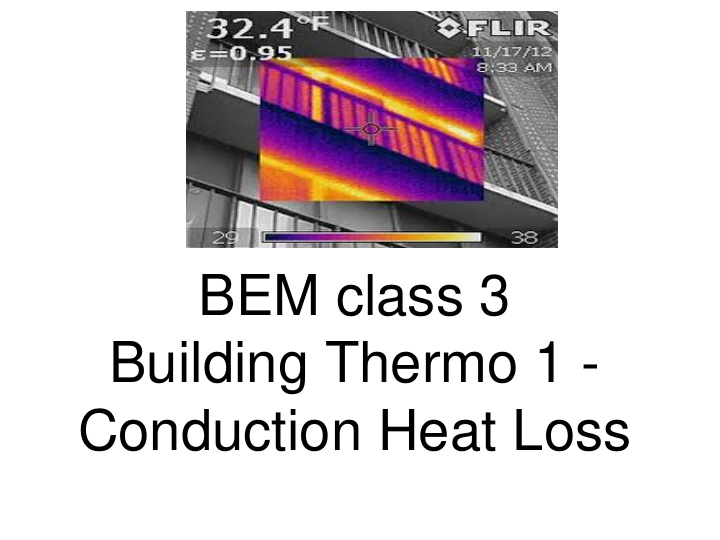



BEM class 3 Building Thermo 1 - Conduction Heat Loss
Building Thermodynamics How buildings lose/gain heat - 3 fundamental mechanisms of heat transfer • Conduction • Convection • Radiation
How Loads are Calculated Heating Load, Q = conduction + infil/ventil [– SG – IG] Cooling Load, Q = conduction + infil/ventil + SG + IG SG = solar gain IG = internal gains For cooling load, infil/ventil includes Latent Heat
Conductive Heat Loss • Heat flows along thermal gradient • Flow proportional to gradient - delta T • Rate of flow characteristic for any material is its "k" or "U" value • BTU / SF / degree dT • Q C = U A dT Remember that this is just for conduction . Heat transfers from air flow and from radiation are equally important in overall heat load calcs.
U-values and R-values • U = 1 / R • Per thickness of material • Look-up tables for tested values. • Field testing with infrared to measure heat flux. • R-values are additive; U-values are NOT.
Conduction in composite constructions Construction elements are not necessarily uniform . fenestration • Varied features • frame characteristics frame walls • compute R at each distinct kind of construction. • Convert to U-values, pro-rating contribution to overall U based on percentage of area (see procedure in table on next slide) Interesting application problem - compute the dew point temperature within a wall construction
Conduction in composite constructions • Brick is uniform - add R-values of layers • Frame wall has different condition at stud - add up the R- values for each construction • Calculate each U and pro-rate (multiply) by percentage of surface area. Add these all up to get an overall U-value for the construction.
Conduction Heat Loss Calculation • Collect, compute, compile R and U values and areas for various constructions (walls, roof, windows). Apply UAdT to each. Sum. (Hmmm, where does that dT come from??) • Can also develop overall envelope U by adding “UA”s -- this weights the U-values proportional to building surface areas. This is the basis of envelope trade-off procedures in Code. • What about foundation and/or slab heat losses?
Code • ASHRAE 90.1 and ICC • State Energy Codes – http://www.dos.ny.gov/dcea/energycode_code.html – http://publicecodes.cyberregs.com/st/ny/st/index.htm • NYC Energy Code – http://www.nyc.gov/html/dob/html/codes_and_reference_materials/nycecc_mai n.shtml – Training Modules http://www.nyc.gov/html/dob/html/codes_and_reference_materials/nycecc_trai ning_modules.shtml • Sallan Foundation "Decoding the Code"
Code cont'd • Focus on envelope insulation values • Compliance pathways • Prescriptive A - meet U values by component • Prescriptive B- meet overall U • "appendix G" modeling against baseline • RESCHECK, COMCHECK - free tools, download, widely used.
"Effective R-value” What you calculate isn’t necessarily what you get • Product and construction flaws • gas-filled windows • insulated walls and insulation by-passes
"Effective R-value” What you calculate isn’t necessarily what you get • Thermal Bridges • “thermal break” construction
Thermal Lags • Building dynamics, non-steady-state • Effect of “thermal mass” • Most important as weather conditions swing daily
Weather data • Not to be confused with CLIMATE data • Climate zones. Design-for- climate. • Design Conditions - dT • Annual Usage - Degree-days. Bins. Hourly.
Weather data cont'd • Sources • "weather tapes" • TMY
Recommend
More recommend